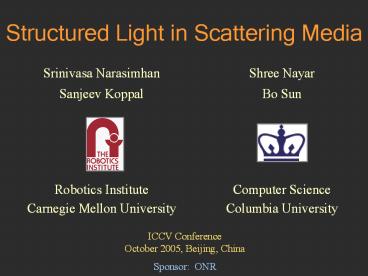Structured Light in Scattering Media - PowerPoint PPT Presentation
Title:
Structured Light in Scattering Media
Description:
Structured Light in Scattering Media – PowerPoint PPT presentation
Number of Views:164
Avg rating:3.0/5.0
Title: Structured Light in Scattering Media
1
Structured Light in Scattering Media
Srinivasa Narasimhan Sanjeev Koppal Robotics
Institute Carnegie Mellon University
Shree Nayar Bo Sun Computer
Science Columbia University
ICCV Conference October 2005, Beijing, China
Sponsor ONR
2
Natural illumination in Scattering Media
Narasimhan and Nayar, 99 - 03, Schechner et al,
01, 04
3
Active illumination in Scattering Media
Levoy et al., Narasimhan-Nayar, Kocak-Caimi,
Jaffe et al., Schechner et al., Negahdaripour et
al.
4
Floodlighting is Bad in Scattering Media
Structured Light Critical for Good Visibility
5
Light Stripe Range Finding in Clear Air
Light Stripe Range Finding in Scattering Media
Light plane
Light plane
Light plane
Source
Source
Camera
Camera
Surface
Surface
6
Light Striping Model in Scattering Media
- Irradiance due to Medium
Surface
Light plane
Phase Function
Extinction coefficient
D
x
s
a
y
Source
D
- Irradiance due to Surface
v
Camera
Radiance
- Final Image Irradiance
7
Light Striping Algorithm in Scattering Media
Surface Intersection from Brightness Profile
No Scattering
Moderate Scattering
Significant Scattering
3D by Triangulation or Temporal Analysis Same
as in clear air.
Medium from Fall-off
Clear-Air Scene Appearance
8
Experimental Setup
Calibration technique similar in spirit to
Grossberg-Nayar 01
9
Experimental Setup and Calibration
Glass
Light Plane
Viewing Ray
- No Refractive index and location of glass or
medium - No explicit calibration of camera and projector
- Similar in spirit to Levoy-Hanrahan 96,
Grossberg-Nayar 01
10
Floodlit Image
Computed Appearance
11
How to Place the Camera and Projector?
Surface
Surface
Camera
Projector
Camera
Projector
Triangulation Issue
Surface Reflectance Issue
12
Smoke and Mirrors
Milk and Mirrors
Planar Mirror seen through Dilute Milk
Light Striping of Mirrors (Dark Intersections)
Reconstruct surfaces with any BRDF if light plane
visible
Discussions with Marc Levoy
13
Photometric Stereo in Clear Air
Pure Air
Distant Source
Orthographic
s
Camera
n
P
Surface
Image Irradiance
Surface normal
Three images required.
Source direction
Albedo
Woodham 80, Horn 86
14
Photometric Stereo in Scattering Media
Scattering
Parallel Rays from
Medium
Distant Source
D
s
Orthographic
s
n
Camera
a
P
Surface
D
v
Image Irradiance
Optical Thickness
Phase Function
15
Photometric Stereo in Scattering Media
Scattering
Parallel Rays from
Medium
Distant Source
D
s
Orthographic
s
n
Camera
a
P
Surface
D
v
5 Parameter Non-linear Optimization (4 per pixel,
1 global)
Five Non-degenerate Sources are Necessary and
Sufficient
16
Simulations Error Histograms
Trials
Trials
Trials
Trials
300 ( x 10 )
300 ( x 10 )
300 ( x 10 )
300 ( x 10 )
250
250
250
250
200
200
200
200
150
150
150
150
100
100
100
100
50
50
50
50
0
0
0
0
0
0.05
0.1
0
0.05
0.1
0
0.05
0.1
0
0.05
0.1
Fractional Error
Fractional Error for
Fractional Error for
Angular Error
for Albedo
Phase Function, g
Optical Thickness
for Normals
Zero error with zero noise. Robust estimation
with 5 uniform noise.
17
Experiments Teapot in Pure Water
18
Experiments Teapot in Dilute Milk
Low Contrast, Flat Appearance
19
Results Traditional Photometric Stereo
3D Shape from NormalsToo Flat
AlbedosScattering effects present
20
Results Our Five-Source Algorithm
3D Shape from Normals
Albedos
21
Results Depth from Photometric Stereo
3D Shape from Normals
Depth mapImpossible using traditional method
22
(No Transcript)
23
Summary
- Structured light improves visibility
- Physics of scattering crucial
- Surprising results possible
- because of scattering































